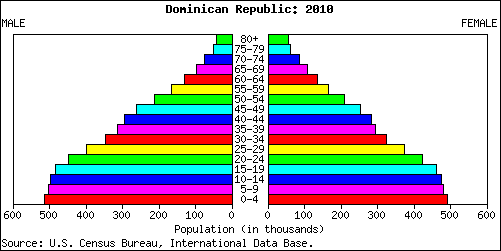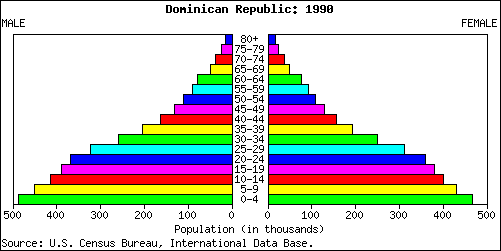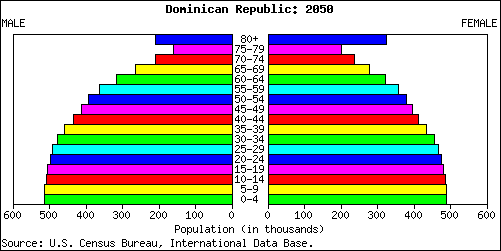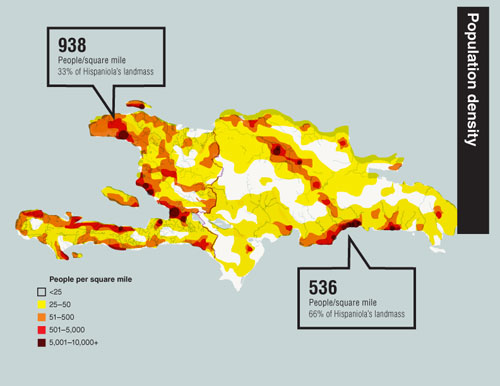The Dominican Republic has had a steady population growth over time
-in 1940 there were about 3 million people
- the population growth rate was about 2.9%
-in 1950 there was a spike in growth rate to 3.6% due to a positive economy
-because of this sudden peak the government began implementing family planning
-late 1970's early 1980's the growth rate declined to 2.5% due to the successful implementing of family planning
-the population growth continued to grow and by the 1990's the population was 7 million
Current Population:
-the population has grown to 10,225,482 as of July 2012
- the growth rate as of July 2012 is 1.305%
-ranked 90 for population growth rate among other countries
-although the growth rate has declined because more people are staying in school to become educated, the population is still growing every year
-ranked 85 in the world for current population
Dominican Republic Distribution:
-most people live in the urban areas
-7,074,135 which is about 69.2%
-a smaller portion of the population lives in the rural areas
-3,151,347 which is about 30.8%
-many people live in coastal cities for the job opportunities with tourism and large companies such as the sugar industry in the city and also for clean water, sewage disposal and electricity
-for example Santo Domingo is one of the largest cities
-many people also live in urban areas near big rivers
-for example the Rio Yaque del Sur river
Fertility Rate:
-2.41 children born/woman
-ranked 90 for fertility rate compared to other countries in the world
Graph:
-the peak in the graph in the 1950's was because of a good economy
-the dip in the graph was when family planning was implemented in the late 1970's

Death Rate:
-4.41 deaths/1,000 people
-ranked 200 in death rate compared to other countries
-the death rate has decreased since 2000
Life expectancy:
-77.44 years on average for the entire population
-male: 75.28 years
-female:79.69 years
-ranked 64 in the world for life expectancy among other countries
Chart:
-the death rate peaked between 2003 and 2005 because all the people who were born during the peak of the 1950's were dying
Country
|
2000
|
2001
|
2002
|
2003
|
2004
|
2005
|
2006
|
2007
|
2008
|
2009
|
2010
|
2011
|
2012
|
Dominican Republic
|
4.72
|
4.7
|
4.68
|
6.88
|
7.1
|
7.35
|
5.73
|
5.32
|
5.3
|
5.28
|
4.3
|
4.35
|
4.41
|
Growth Rate:
- the growth rate as of July 2012 is 1.305%
-ranked 90 for population growth rate among other countries
-the growth rate has decreased
-due to education and schooling becoming more popular women are waiting longer to have children
-with implementing family planning still in effect the growth rate has been controlled so there are only minor decreases or increases
Country
|
2000
|
2001
|
2002
|
2003
|
2004
|
2005
|
2006
|
2007
|
2008
|
2009
|
2010
|
2011
|
2012
|
Dominican Republic
|
1.64
|
1.63
|
1.61
|
1.36
|
1.33
|
1.29
|
1.47
|
1.5
|
1.5
|
1.49
|
1.36
|
1.33
|
1.31
|
Doubling Time:
-53.44 years
-this has remained a constant for the past 20 years give or take a few minor fluctuations in increasing or decreasing growth
Demographic Transition:
-currently in stage 2 with a high birth rate and a declining death rate
-with birth rates slowly declining the country is looking at many more years until they move toward the beginning of stage 3
-still high birth rates because not many people go to school and family planning is an important issue
-the government is trying to encourage more people to stay in school and implement family planning however it will take time to move through demographic transition
-there are still reasonably high death rates compared to other countries because of the lack of clean water, sewage disposal and electricity in many areas of the country

| Age Structure: (as of July 2011) -0-14 years old: 29% (male 1,487,058/female 1,435,903) -15-64 years old: 64.3% (male 3,311,791/ female 3,178,705) -65 years and older: 6.7% (male 311,811/female 363,330) Current Structure: -compared to the past age structure, the current age structure is becoming more rounded between all the ages instead of having a bigger population between the ages 0-34 years old and the elder people having a longer life expectancy than in 1990  1990's Structure: -the past age structure of 1990 had a smaller population in the elder people and a larger population in the younger people because of the high death rates and having a shorter life expectancy in 1990's  2050's Structure: -the future age structure of 2050 is predicted to be well rounded among all the ages with elder people having a smaller population because of slightly higher death rates however still a bigger population than the 1990 structure because of a much longer life expectancy  Sustainability of Population: -the current growth and size is not sustainable -with a large population there is not enough food or water for all the people -there are not enough jobs and since many people are moving to coastal cities there is limited space Diseases: -food or water born diseases: bacterial diarrhea, hepatitis A, typhoid fever -water contact disease: leptospirosis Hunger: -21% of population suffering from hunger -2,147,351 suffering from hunger Strategies to Sustain the Population: -implementing better family planning programs -transfer money to improve health care systems -get a stricter immigration policy -work to create water treatment plants -work to create proper sewage disposal Recommendations: -create incentives for kids to stay in school longer to help keep the growth rate down -continue to implement family planning policies -incentives for families with less children (ex. cash benefits) |

